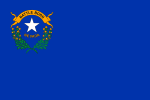Tule Springs Fossil Beds National Monument
2014 establishments in NevadaCenozoic paleontological sites of North AmericaFossil parks in the United StatesNational Monuments designated by Barack ObamaNational Park Service National Monuments in Nevada ... and 3 more
Paleontology in NevadaProtected areas established in 2014Protected areas of Clark County, Nevada

Tule Springs Fossil Beds National Monument, a United States National Monument near Las Vegas, Clark County, Nevada, was established in 2014 to protect Ice Age paleontological discoveries. The 22,650-acre (9,170 ha) monument is administered by the National Park Service.The national monument is located in the Upper Las Vegas Wash and protects part of the Tule Springs. The wash area also includes several patches of the rare Las Vegas bear poppy. The land was designated after a local campaign to permanently protect the landscape as a national monument.
Excerpt from the Wikipedia article Tule Springs Fossil Beds National Monument (License: CC BY-SA 3.0, Authors, Images).Tule Springs Fossil Beds National Monument
Las Vegas
Geographical coordinates (GPS) Address Nearby Places Show on map
Geographical coordinates (GPS)
| Latitude | Longitude |
|---|---|
| N 36.371 ° | E -115.306 ° |
Address
Las Vegas
Las Vegas
Nevada, United States
Open on Google Maps






